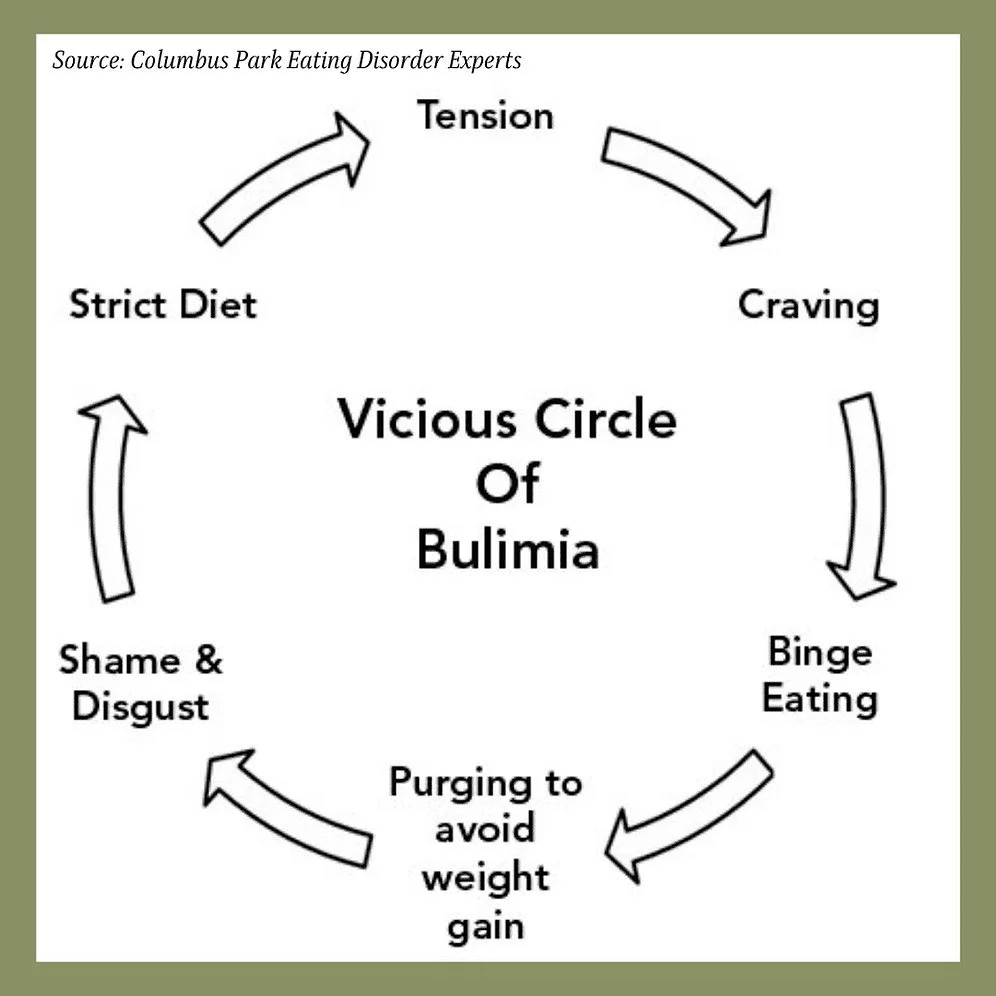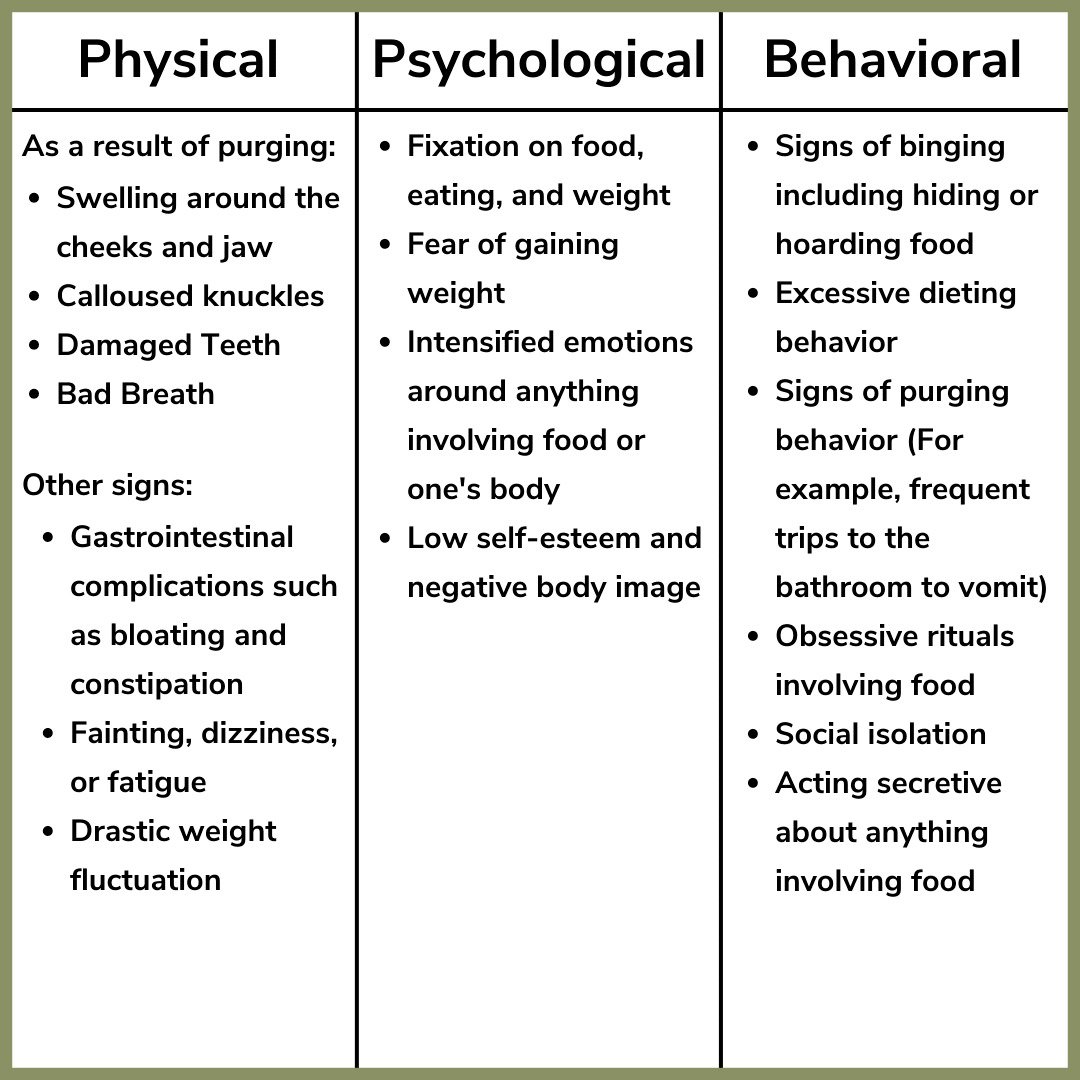Bulimia Nervosa Explained
Everyone has moments when they eat a bit more than they normally would. Especially during the holiday season! This is totally normal, even more so during holidays like Thanksgiving when a delicious dinner surrounded by family and friends is prepared. When most people overindulge, it's not something that happens all the time. But for people who suffer from Bulimia Nervosa, binges can happen multiple times a week.
What is Bulimia?
Bulimia Nervosa is an eating disorder involving the consumption of large amounts of food and experiencing a loss of control while doing so. This is usually done within a short time, resulting in feelings of shame or guilt. Consequently, someone with bulimia will implement compensatory behaviors to "make up" for the episode.
What are Compensatory Behaviors?
People suffering from bulimia practice compensatory behaviors in an attempt to cancel out the effects of eating, one of the most common reasons being weight gain. After binging, feelings of shame and guilt arise, compelling that person to try to relieve themselves of those feelings by compensating. Some examples of compensatory behaviors include:
Self-induced vomiting
Abusing laxatives or diuretics
Excessive exercise
Fasting
Compensatory behaviors fall into two categories: purging and non-purging. According to John Hopkins Medicine, someone that uses purging behaviors "engages in self-induced vomiting or misuse of laxatives, diuretics, or enemas, or other medicines that clear the intestines". The non-purging type "uses other behaviors, such as fasting or excessive exercise, rather than purging behaviors" to compensate for the episodes of overconsumption.
People suffering from bulimia get stuck in a cycle of eating without control followed by attempts to compensate for the episodes, making them feel remorseful and ashamed. The longer someone gets stuck in this cycle, the more control they lose over themselves and their behaviors become more compulsive. This leads to an obsession with eating (or not eating), food, dieting, weight loss, and body image (National Eating Disorders Collaboration).
Bulimia vs Binge Eating Disorder (BED) and Anorexia
If you are familiar with the more common types of eating disorders, you may have noticed that bulimia sounds very similar to BED, or Binge Eating Disorder. The similarities between BED and bulimia include the following:
Recurring episodes of eating large quantities of food in a short time
Feeling a loss of control during binging episodes
Experiencing feelings of shame and guilt during and/or after a binging episode
The main difference between bulimia and BED is compensatory behaviors. People with BED do not practice compensatory behaviors to counteract binging episodes, while those with bulimia do.
Behaviors seen in people with bulimia can also look similar to those who suffer from anorexia. In fact, it is very common for people who suffer from bulimia or anorexia to bounce back and forth between the two disorders over time as they suffer from their effects. Regardless of what the most prevalent symptoms of any eating disorder are, it's important to remember that there are a lot of variances and everyone's experience is different.
Bulimia Statistics
"Surveys show a rate of approximately 1.5 percent of the US female population and 0.5 percent of the male population has experienced bulimia in their lifetimes. These percentages translate to 4.7 million females and 1.5 million males" (American Addiction Centers). Most of the people affected are in their teenage years. However, it does occur in people even younger and in the elderly, just not as often.
According to the American Addiction Centers, a study conducted within a certain time frame found a mortality rate of 3.9% for bulimia. This was found by analyzing the cause of death in death certificates across the United States. "The rate of fatalities that involved bulimia, or that were caused by this disorder, is likely to be higher because coroners may list an associated condition as the cause of death, such as cardiac arrest" (American Addiction Centers).
Similar to other eating disorders, it's estimated that only 1 in 10 people diagnosed receive proper treatment. Even after receiving treatment, bulimia can return, which is why it's important to always seek help if it's needed.
Warning Signs of Bulimia
Bulimia has a combination of physical, psychological, and behavioral warning signs. Some of these signs from the National Eating Disorders Collaboration's website include:
Although these are the primary signs of bulimia, it is possible for people suffering from the disorder to show a combination of them or no obvious signs at all.
Medical Complications Caused by Bulimia
All eating disorders have dangerous consequences. A common result of practicing eating disorder behaviors is heart complications. Regarding bulimia, dehydration is seen often as a result of repetitive purging.
"Dehydration decreases the blood pressure and ultimately harms every organ of our body. The heart and kidneys are particularly sensitive to low fluid intake" (The Emily Program). Purging also reduces mineral and electrolyte intake, worsening the heart's condition.
Dental problems are another prevalent medical complication caused by bulimia. Vomiting repeatedly causes your teeth to deteriorate over time from being exposed to stomach acid. This damage is permanent and can lead to discoloration of the teeth and changes in their shape. Once your teeth erode, eating and drinking become painful because of increased sensitivity to hot and cold temperatures.
Teeth aren't the only dental complication- your gums and soft tissues in your mouth also become damaged. Exposing the inside of your mouth to stomach acid from purging too many times can cause lesions anywhere inside of the mouth and even in the back of your throat. "Frequent vomiting also results in canker sores, redness, pain in the mouth, and enlarged salivary glands, which may cause swollen cheeks" (The Emily Program).
If you would like to read more in-depth about medical complications caused by bulimia, check out the blog "Physical Effects of Bulimia Nervosa" on The Emily Program's website, here.
Bulimia is dangerous and should never be handled by watching and waiting. If you or someone you know may be suffering from bulimia or any other type of eating disorder, visit The Bulimia Project's website for an extensive list of resources you can use to reach out to for help. The sooner you get help, the sooner you can recover ❤
This post is for educational and informational purposes only. It is not a substitute for medical advice, diagnosis, or treatment.
Enjoy Reading Our Blog Posts?
Consider making a donation to help us help others and continue to educate people on eating disorders, body image issues, and trauma.
Sources:
American Addiction Centers. (2022, September 14). Finding a Bulimia Treatment Center. American Addiction Centers. Retrieved November 23, 2022, from https://americanaddictioncenters.org/bulimia-treatment
Bulimia Nervosa. Bulimia Nervosa | Johns Hopkins Medicine. (2019, November 19). Retrieved November 23, 2022, from https://www.hopkinsmedicine.org/health/conditions-and-diseases/eating-disorders/bulimia-nervosa
Colleen Stiles-Shields, E., Labuschagne, Z., Goldschmidt, A. B., Doyle, A. C., & Le Grange, D. (2012, July). The use of multiple methods of compensatory behaviors as an indicator of eating disorder severity in treatment-seeking youth. The International Journal of Eating Disorders. Retrieved November 23, 2022, from https://www.ncbi.nlm.nih.gov/pmc/articles/PMC3355214/#:~:text=Compensatory%20behaviors%20include%20self%2Dinduced,2
Eating Recovery Center. (n.d.). Bulimia Nervosa: Symptoms, causes, risks, & treatment. Eating Recovery Center. Retrieved November 23, 2022, from https://www.eatingrecoverycenter.com/conditions/bulimia
Michel, A. (2022, April 19). Cardiac Complications of Eating Disorders. The Emily Program. Retrieved November 23, 2022, from https://www.emilyprogram.com/blog/cardiac-complications-of-eating-disorders/
National Eating Disorder Collaboration. (2022, October 12). Bulimia Nervosa. NEDC. Retrieved November 23, 2022, from https://nedc.com.au/eating-disorders/eating-disorders-explained/types/bulimia-nervosa/
Todd, T. E. P. (2022, February 1). Physical Effects of Bulimia Nervosa. The Emily Program. Retrieved November 23, 2022, from https://www.emilyprogram.com/blog/physical-effects-of-bulimia-nervosa/






